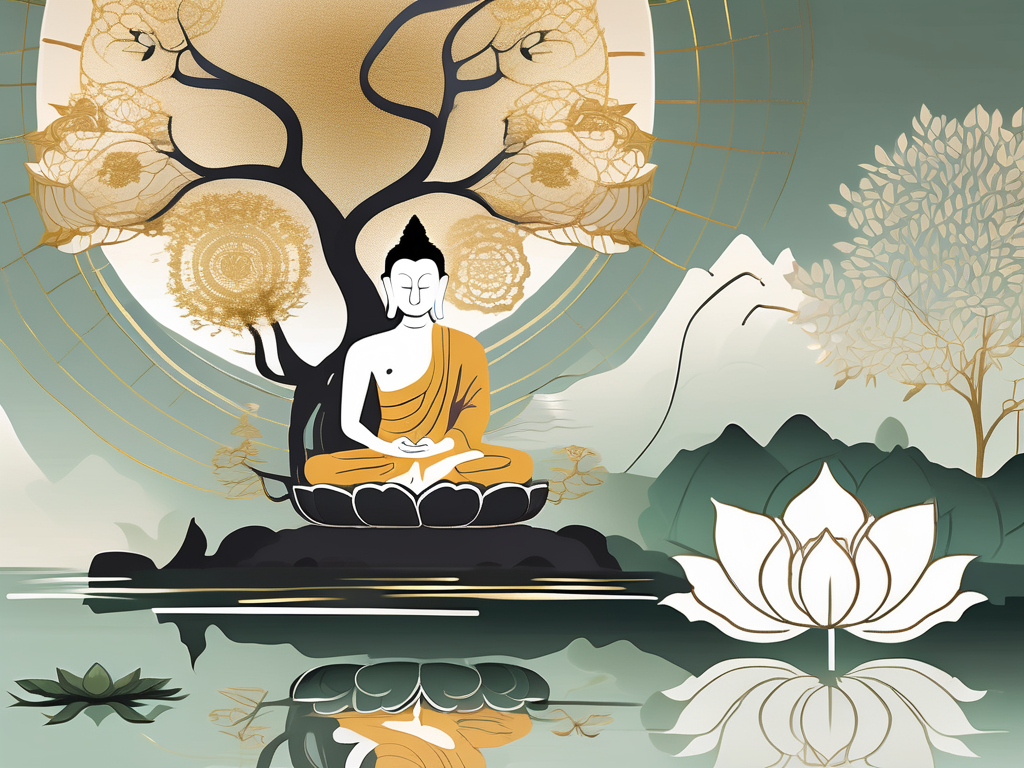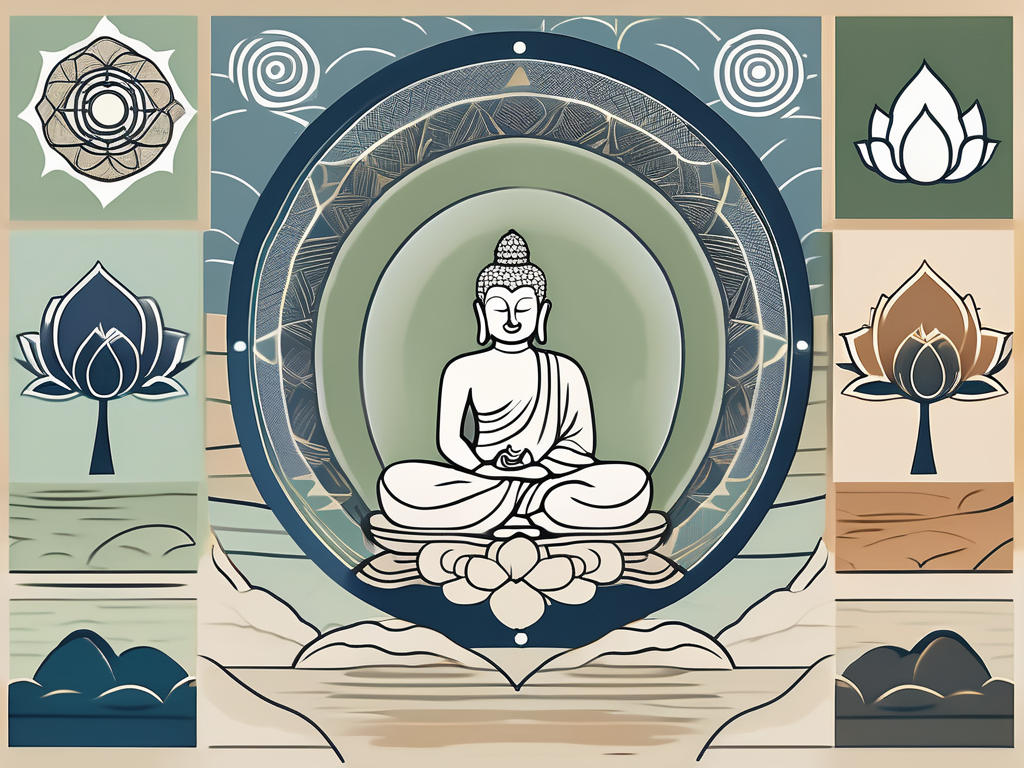Mahayana Buddhism has a rich and fascinating history that spans thousands of years. In this comprehensive exploration, we will delve into the origins, principles, evolution, teachings, and current practices of this profound and influential school of Buddhism. So grab a cup of tea, settle into a comfortable chair, and get ready to embark on a journey through the realms of Mahayana Buddhism.
Understanding Mahayana Buddhism
Mahayana Buddhism is a branch of Buddhism that emerged around the 1st century CE. It is characterized by its emphasis on compassion, wisdom, and the aspiration to attain enlightenment not only for oneself but also for the benefit of all sentient beings. Central to Mahayana Buddhism are the concepts of emptiness and the Bodhisattva ideal.
Mahayana Buddhism encompasses a rich and diverse array of teachings, practices, and traditions. It has spread across various regions, including East Asia, Southeast Asia, and the Himalayan regions. This widespread influence has resulted in the development of unique cultural expressions and interpretations of Mahayana Buddhism in different countries.
Key Principles of Mahayana Buddhism
At the core of Mahayana Buddhism are three key principles: the belief in the interdependence and interconnectedness of all things (known as interbeing), the doctrine of emptiness, and the Bodhisattva ideal. Interbeing teaches us that everything in the universe is deeply intertwined and that our actions have an impact on ourselves and others.
Interbeing encourages practitioners to cultivate a deep sense of interconnectedness and to recognize the importance of ethical conduct and compassionate action. It emphasizes the interdependent nature of reality, highlighting the interconnectedness of all beings and the environment in which they exist.
The doctrine of emptiness asserts that there is no inherent, independent existence of any phenomena. This understanding leads to the realization of the illusory nature of the self and the world around us, ultimately liberating us from suffering.
Emptiness is not a nihilistic concept but rather a profound insight into the nature of reality. It invites practitioners to investigate the nature of existence and to transcend conceptual limitations in order to perceive the interconnectedness and interdependence of all things.
The Bodhisattva ideal, perhaps one of the most distinctive features of Mahayana Buddhism, is the aspiration to attain enlightenment and then stay in the cycle of birth and death to guide and assist others on their own paths towards liberation.
The Bodhisattva ideal is rooted in the deep compassion and altruistic intention to alleviate the suffering of all sentient beings. It is a commitment to put the welfare of others before oneself and to actively engage in compassionate actions that promote the well-being and liberation of all beings.
The Role of Bodhisattvas in Mahayana Buddhism
In Mahayana Buddhism, Bodhisattvas are regarded as compassionate and awakened beings who have chosen to postpone their own enlightenment to help all sentient beings reach liberation. They are revered as ultimate sources of inspiration and guidance, embodying compassion, wisdom, and skillful means in their selfless pursuit of delivering others from suffering.
Bodhisattvas are seen as exemplars of the Bodhisattva ideal, demonstrating the path of compassion and wisdom through their own actions and teachings. They serve as role models for practitioners, inspiring them to cultivate the qualities of compassion, wisdom, and selflessness in their own lives.
Bodhisattvas are often depicted in Mahayana Buddhist art and revered through various practices and rituals. Their images and statues adorn temples and monasteries, serving as reminders of the potential for awakening and the importance of cultivating compassion in one’s own life.
Devotion to Bodhisattvas is expressed through various practices, such as chanting their names, reciting their mantras, and engaging in visualizations and meditations on their qualities. These practices aim to establish a deep connection with the Bodhisattvas and to invoke their blessings and guidance on the path towards enlightenment.
Ultimately, Mahayana Buddhism offers a profound and inclusive path towards liberation, emphasizing the interconnectedness of all beings and the importance of compassionate action. It invites practitioners to cultivate wisdom, compassion, and selflessness in order to alleviate suffering and contribute to the well-being and liberation of all sentient beings.
Tracing the Origins of Mahayana Buddhism
The emergence of Mahayana Buddhism in the 1st century CE marked a significant shift in the teachings and practices of Buddhism. While Theravada Buddhism focused on personal liberation and the attainment of Nirvana, Mahayana Buddhism placed greater emphasis on the altruistic ideal of the Bodhisattva and the pursuit of enlightenment for the benefit of all sentient beings.
But how did Mahayana Buddhism come to be? The reasons for its emergence are complex and multifaceted, reflecting the intricate tapestry of ancient India’s social, political, and religious landscape.
The Emergence of Mahayana Buddhism
Some scholars believe that Mahayana Buddhism was a response to the changing social and political dynamics of ancient India. As urbanization increased and diverse religious beliefs flourished, the need for a more inclusive and accessible form of Buddhism became apparent. Mahayana Buddhism, with its emphasis on compassion and the Bodhisattva ideal, provided a path that resonated with the changing needs and aspirations of the people.
Others argue that the emergence of Mahayana Buddhism was a result of new interpretations and developments within the Buddhist tradition itself. As the teachings of the Buddha spread and evolved, different schools of thought emerged, each with its own unique perspective on the path to enlightenment. Mahayana Buddhism, with its emphasis on the universal liberation of all beings, represented a radical departure from the more individualistic focus of Theravada Buddhism.
Regardless of its exact origins, Mahayana Buddhism quickly gained popularity and spread throughout various regions of Asia, leaving a lasting impact on the religious and cultural landscape of the continent.
Theories about the Birthplace of Mahayana Buddhism
The birthplace of Mahayana Buddhism is a topic of much speculation and debate among historians and scholars. While it is widely believed to have originated in India, the exact location is uncertain.
One theory suggests that Mahayana Buddhism emerged in the region of Gandhara, which encompasses parts of present-day Afghanistan and Pakistan. Gandhara, with its rich cultural and religious diversity, was a melting pot of ideas and influences, making it a fertile ground for the development of new religious movements.
Another theory proposes North India as the birthplace of Mahayana Buddhism. This region, known for its intellectual and spiritual vibrancy, was home to numerous Buddhist monastic centers and renowned scholars. It is believed that the intellectual ferment in North India during this time gave rise to the innovative ideas and practices that characterize Mahayana Buddhism.
Regardless of its exact geographical origins, Mahayana Buddhism found fertile ground for its development and propagation throughout Asia. From India, it spread to countries such as China, Japan, Korea, and Vietnam, leaving a profound and enduring legacy in the countries it touched.
The Evolution of Mahayana Buddhism
Over the centuries, Mahayana Buddhism underwent a process of evolution and transformation as it spread across Asia. It adapted to local cultures, assimilated indigenous beliefs and practices, and became a vibrant and diverse tradition.
The story of Mahayana Buddhism’s evolution is a testament to its ability to adapt and thrive in different cultural contexts. As it expanded its reach, Mahayana Buddhism encountered a rich tapestry of traditions and religious beliefs, each with its own unique flavor and practices.
The Spread of Mahayana Buddhism across Asia
As Mahayana Buddhism expanded its reach, it encountered and incorporated various cultural traditions and religious beliefs. In China, for example, Mahayana Buddhism merged with Daoism and Confucianism, giving rise to unique syncretic traditions such as Chan (Zen) Buddhism and Pure Land Buddhism.
The fusion of Mahayana Buddhism with Daoism and Confucianism in China resulted in a fascinating blend of philosophies and practices. Chan Buddhism, with its emphasis on direct experience and meditation, drew inspiration from Daoist principles of spontaneity and naturalness. Pure Land Buddhism, on the other hand, offered a devotional path to enlightenment, appealing to those seeking solace and salvation in a world filled with suffering.
In Japan, the influence of Mahayana Buddhism can be seen in the development of schools such as Tendai, Shingon, and Nichiren Buddhism. Each of these schools has its own distinct practices and teachings, shaped by the cultural and historical context in which they arose.
Tendai Buddhism, for instance, incorporated elements of esoteric rituals and teachings from China’s Tiantai tradition. Shingon Buddhism, founded by the renowned monk Kukai, emphasized the use of mantras, mudras, and mandalas as powerful tools for spiritual transformation. Nichiren Buddhism, named after its founder Nichiren, focused on the chanting of the Lotus Sutra as a means to attain enlightenment in this very lifetime.
The Influence of Cultural Exchange on Mahayana Buddhism
Throughout its history, Mahayana Buddhism has been shaped by the cultural exchange between different countries and regions. The transmission of Buddhist texts, art, and practices through trade routes such as the Silk Road played a crucial role in disseminating Mahayana teachings and establishing thriving Buddhist centers across Asia.
This cultural exchange not only enriched Mahayana Buddhism but also facilitated the spread of knowledge, ideas, and wisdom across diverse communities. Buddhist monks and scholars traveled along the Silk Road, exchanging insights with people of different cultures and religions. They brought back new texts, artistic styles, and philosophical ideas, which were then integrated into the evolving tapestry of Mahayana Buddhism.
The cultural exchange between Mahayana Buddhism and other traditions also influenced the development of philosophy, art, and religious practices in the regions touched by Mahayana Buddhism. For example, the spread of Mahayana Buddhism to Tibet gave rise to the unique Tibetan Buddhist tradition, with its distinctive rituals, monastic practices, and philosophical systems.
Furthermore, the influence of Mahayana Buddhism extended beyond Asia. In the 19th and 20th centuries, Mahayana teachings reached the shores of the Western world, where they continue to inspire and transform the lives of countless individuals.
The evolution of Mahayana Buddhism is a testament to its resilience and adaptability. It has embraced the diversity of human experience, incorporating different cultural traditions and beliefs, and continues to evolve as it encounters new challenges and opportunities in the modern world.
The Teachings and Texts of Mahayana Buddhism
Central to the practice of Mahayana Buddhism are its sacred texts, which serve as a guide for aspirants on the path of awakening. Among the vast array of Mahayana sutras, the Lotus Sutra holds a prominent place.
The Lotus Sutra and its Significance
The Lotus Sutra is one of the most revered and influential texts in Mahayana Buddhism. It presents the teachings of the Buddha in a profound and accessible manner, emphasizing the universality of awakening and the boundless potential for enlightenment inherent in all sentient beings.
The Lotus Sutra teaches that all beings possess the Buddha nature, the innate capacity for liberation and enlightenment. It encourages practitioners to embrace this inherent potential and cultivate wisdom and compassion in their daily lives.
The Role of Meditation in Mahayana Buddhism
Meditation is an integral part of Mahayana Buddhist practice, serving as a means of cultivating mindfulness, concentration, and insight. Different forms of meditation are employed to develop specific qualities and states of mind, such as loving-kindness, compassion, and emptiness.
Through meditation, practitioners deepen their understanding of the nature of reality and cultivate the qualities necessary for the realization of enlightenment. It is through this diligent practice that one can unravel the layers of delusion and achieve a direct experience of the ultimate truth.
Mahayana Buddhism Today
As we fast forward to the present day, we find Mahayana Buddhism thriving in various parts of the world. Its teachings and practices continue to evolve, adapting to the unique challenges and opportunities of the modern era.
Modern Practices and Beliefs in Mahayana Buddhism
Contemporary Mahayana Buddhism encompasses diverse practices and beliefs that cater to the needs and inclinations of practitioners. From monastic traditions to lay communities, individuals engage in rituals, chanting, meditation, and other spiritual practices to deepen their connection with the Dharma.
Moreover, modern advancements in technology and globalization have facilitated the exchange of ideas and wisdom among communities of practitioners, creating opportunities for dialogue, learning, and collaboration.
The Impact of Mahayana Buddhism on Contemporary Society
Mahayana Buddhism continues to exert a profound influence on contemporary society, both directly and indirectly. Its teachings of compassion and interbeing inspire individuals to act with kindness and empathy, promoting social harmony and environmental stewardship.
Furthermore, the rich cultural and artistic heritage associated with Mahayana Buddhism has had a significant impact on various fields, including art, literature, philosophy, and psychology. The concepts and symbols derived from Mahayana Buddhism continue to inspire and resonate with people of diverse backgrounds and perspectives.
In Conclusion
Our comprehensive exploration of the origin, principles, evolution, teachings, and current practices of Mahayana Buddhism has provided us with a deeper understanding of this profound spiritual tradition. From its humble beginnings to its far-reaching influence, Mahayana Buddhism exemplifies the boundless potential for awakening and the power of compassion in transforming both individual lives and society as a whole.
May our exploration of Mahayana Buddhism inspire us to cultivate wisdom, compassion, and interconnectedness in our own lives, and may it serve as a reminder of the vast possibilities inherent in the pursuit of enlightenment.












